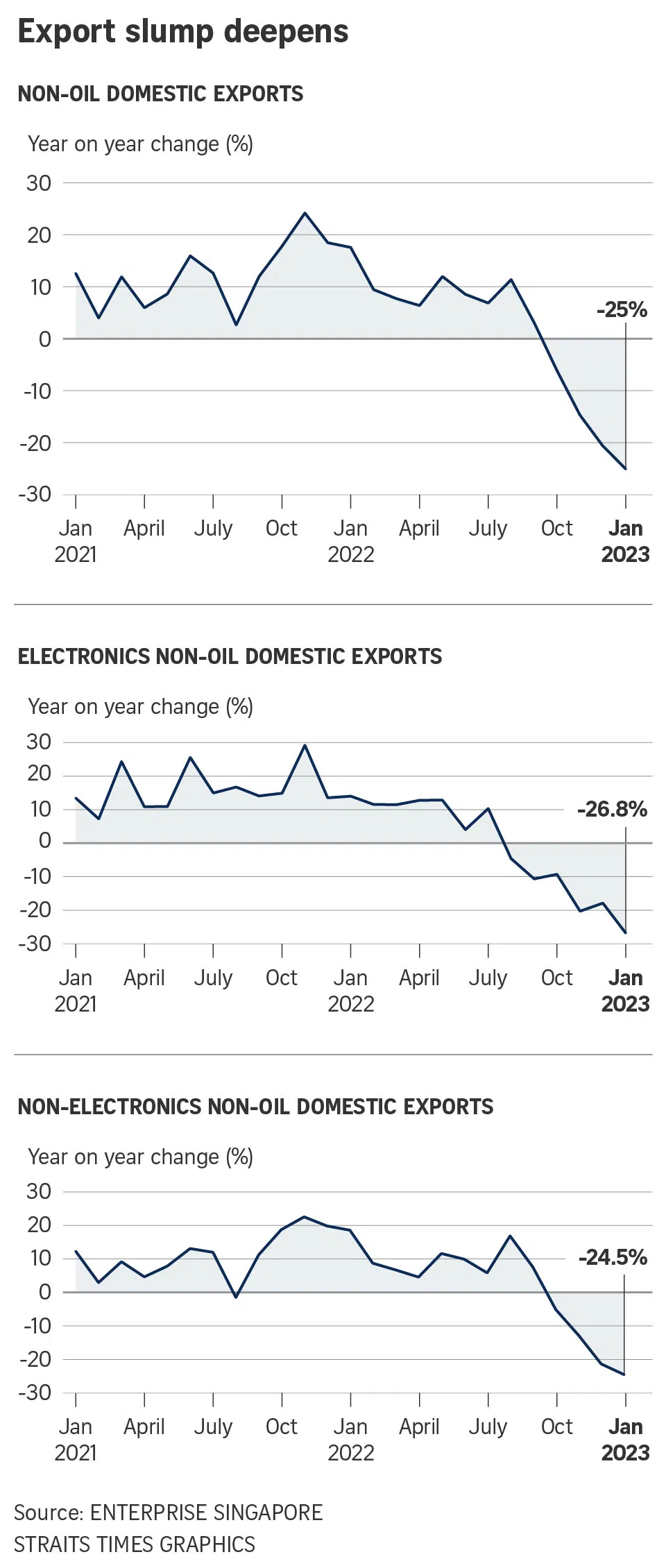Singapore non-oil exports miss forecasts, slipping 25% in January
Sign up now: Get ST's newsletters delivered to your inbox

On a seasonally adjusted basis, January’s Nodx came in at $14.5 billion.
PHOTO: ST FILE
Follow topic:
SINGAPORE – Singapore’s key exports slumped for the fourth straight month in January, according to data from Enterprise Singapore (EnterpriseSG) on Friday, on rapidly cooling demand from some of the city-state’s key export markets.
Non-oil domestic exports (Nodx) for January fell by a sharper 25 per cent from a high base a year ago.
January’s figures were worse than the 20.6 per cent contraction in December
On a seasonally adjusted basis, January’s Nodx came in at $14.5 billion.
This was higher than the previous month’s $14.3 billion, EnterpriseSG noted. But it was lower than 2022’s monthly average of $16.6 billion.
Both electronic and non-electronic exports extended their decline in January, with double-digit contractions for many products.
Electronic Nodx, which accounts for around a quarter of domestic exports, fell 26.8 per cent from a year ago, after declining 17.9 per cent in December.
Integrated circuits, disk media products and parts of personal computers contributed most to the decline in electronic Nodx.
UOB senior economist Alvin Liew said electronic exports have now dropped for six straight months.
“This is the first time since March 2020 that the nominal value of electronic exports has fallen below $3 billion,” said Mr Liew.
Non-electronic Nodx fell 24.5 per cent year on year, after declining 21.3 per cent in December.
Non-monetary gold, structures of ships and boats, and specialised machinery contributed most to the decline in non-electronic Nodx.
Only the volatile pharmaceuticals segment managed to post positive year-on-year growth of 22.8 per cent.
ANZ head of Asia research Khoon Goh said exports started weakening in August 2022, as the slowdown in advanced economies and the downturn in the semiconductor cycle began to flow through.
The picture was slightly brighter on a month-on-month seasonally adjusted basis.
Nodx increased by 0.9 per cent in January, after the revised drop of 2.9 per cent in the previous month, the first month-on-month increase after five consecutive months of decline, said Mr Liew.
The figure also beat Bloomberg’s forecast for a contraction of 1.2 per cent month on month.
Looking at Singapore’s exports to its top 10 markets, it was a sea of red against a backdrop of weak global demand.
Shipments to China, the United States and Hong Kong fell by double-digit percentages in January.
Shipments to the US plunged 31.5 per cent, extending the fall from the previous month’s 1.9 per cent contraction.
This was the second month of lower exports to the US, following six months of growth.
The slump in shipments to China continued, down another 41.1 per cent in January.
Only shipments to the European Union and Japan rose.
The numbers from the EU were particularly comforting as Nodx rose 21.4 per cent in January, reversing the 3.7 per cent decline in December.
Shipments to Japan rose by a smaller 1.4 per cent in January, after climbing 6.8 per cent in December.
Intra-regional trade also continued to weaken, with shipments to Indonesia, Malaysia and Thailand all in the red.
The Nodx forecast for 2023 is for minus 2 per cent to 0 per cent growth, EnterpriseSG maintained in its trade review on Monday.
Mr Goh expects Nodx to remain weak and for the net export sector to weigh on growth in the first half of 2023.
He does not expect China’s reopening to provide much relief in the near term.
“The prime beneficiary would be China’s internal demand (largely services, which have little import content),” said Mr Goh.
OCBC Bank’s chief economist Selena Ling also thinks exports may remain soft in the next few months until there are clearer signs of Chinese demand picking up.
“Fortunately, the US and EU have avoided a growth contraction in the fourth quarter, and the recent signs appear to be pointing to a soft landing rather than a hard landing ahead,” she said.
Together, these two markets account for a 28.4 per cent share of Singapore’s key exports, according to EnterpriseSG data.
Singapore is one of the most export-driven economies in the world, with an exports to gross domestic product ratio of about 180 per cent.



